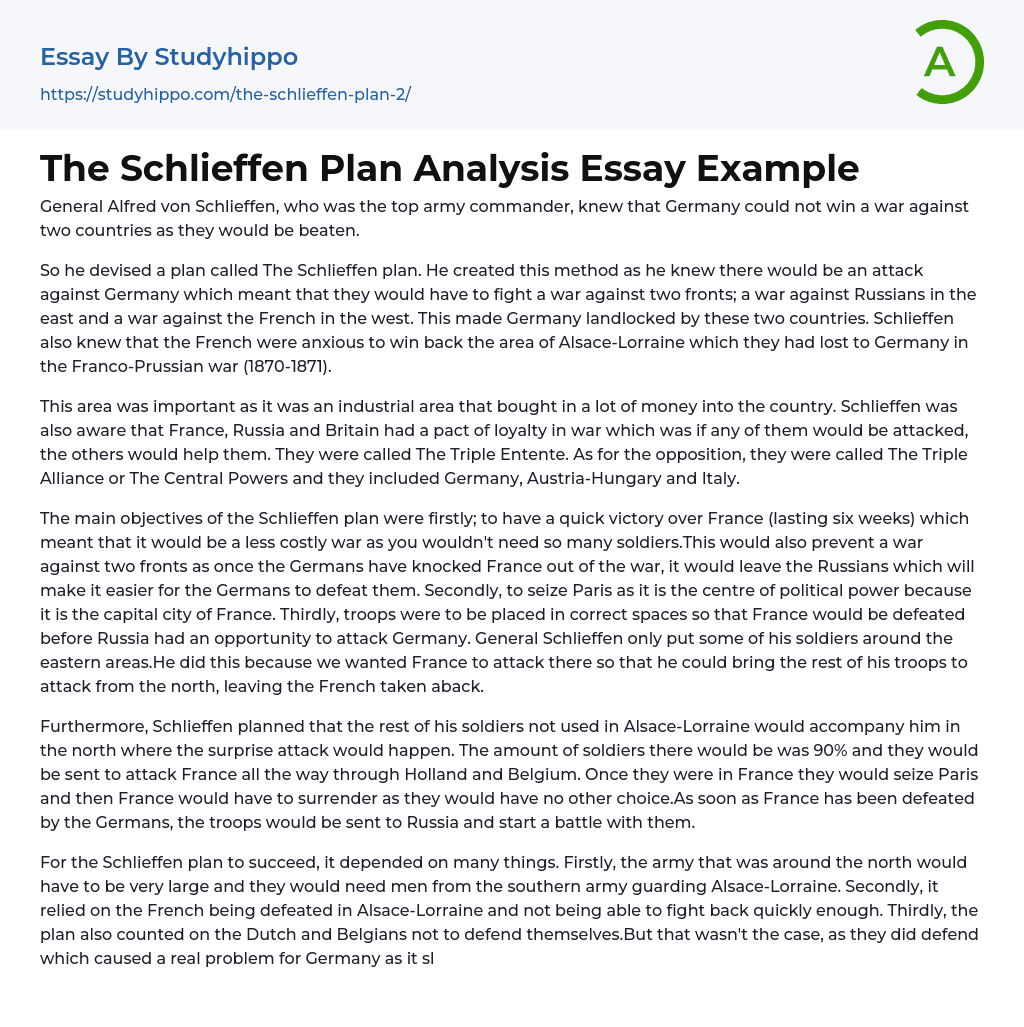General Alfred von Schlieffen, who was the top army commander, knew that Germany could not win a war against two countries as they would be beaten.
So he devised a plan called The Schlieffen plan. He created this method as he knew there would be an attack against Germany which meant that they would have to fight a war against two fronts; a war against Russians in the east and a war against the French in the west. This made Germany landlocked by these two countries. Schlieffen also knew that the French were anxious to win back the area of Alsace-Lorraine which they had lost to Germany in the Franco-Prussian war (1870-1871).
This area was important as it was an industrial area that bought in a lot of money into the country. Schlieffen was also aware that
...France, Russia and Britain had a pact of loyalty in war which was if any of them would be attacked, the others would help them. They were called The Triple Entente. As for the opposition, they were called The Triple Alliance or The Central Powers and they included Germany, Austria-Hungary and Italy.
The main objectives of the Schlieffen plan were firstly; to have a quick victory over France (lasting six weeks) which meant that it would be a less costly war as you wouldn't need so many soldiers.This would also prevent a war against two fronts as once the Germans have knocked France out of the war, it would leave the Russians which will make it easier for the Germans to defeat them. Secondly, to seize Paris as it is the centre of political power because it is th
capital city of France. Thirdly, troops were to be placed in correct spaces so that France would be defeated before Russia had an opportunity to attack Germany. General Schlieffen only put some of his soldiers around the eastern areas.He did this because we wanted France to attack there so that he could bring the rest of his troops to attack from the north, leaving the French taken aback.
Furthermore, Schlieffen planned that the rest of his soldiers not used in Alsace-Lorraine would accompany him in the north where the surprise attack would happen. The amount of soldiers there would be was 90% and they would be sent to attack France all the way through Holland and Belgium. Once they were in France they would seize Paris and then France would have to surrender as they would have no other choice.As soon as France has been defeated by the Germans, the troops would be sent to Russia and start a battle with them.
For the Schlieffen plan to succeed, it depended on many things. Firstly, the army that was around the north would have to be very large and they would need men from the southern army guarding Alsace-Lorraine. Secondly, it relied on the French being defeated in Alsace-Lorraine and not being able to fight back quickly enough. Thirdly, the plan also counted on the Dutch and Belgians not to defend themselves.But that wasn't the case, as they did defend which caused a real problem for Germany as it slowed down their soldiers.
Fourthly, it depended on its soldiers to walk 35km per day with superb logistics. This means the handling of troops in battle supplied
with food and equipment, ammunition etc. Fifthly, it relied on the British Neutrality which meant that Britain wouldn't join in the war as they took neither side in the war. But that's not what happened. They sent over the British Expeditionary Force (BEF).They were a small group but highly skilled in battle as they showed they slowed down the Germans in the Battle of Mame.
The last thing the Schlieffen plan needed to succeed was a slow Russian mobilisation which meant the Germans thought it would take the Russians 3 months to fight back. They thought this because Russia had a poor infrastructure; e. g. -poor communication and transport links. The Russian leader Tsar Nicholas II (1894-1917), shown in this picture here on the left, was a weak leader and Russia had proved to be a fading power after losing the Russia and Japanese war in 1905.
- Air Force essays
- Army essays
- Soldiers essays
- Army Values essays
- United States Army essays
- Veteran essays
- Aircraft essays
- Sergeant essays
- World War I essays
- World War Ii essays
- Atomic Bomb essays
- American Civil War essays
- Attack essays
- Cold War essays
- Crimean War essays
- Emilio Aguinaldo essays
- Iraq War essays
- Korean War essays
- Nazism essays
- Nuclear Weapon essays
- Philippine Revolution essays
- Trench Warfare essays
- Vietnam War essays
- Western Front essays
- Diplomacy essays
- Emperor essays
- Rwanda essays
- Tribe essays
- Revolutionary War essays
- War of 1812 essays
- Mexican American War essays
- Hitler essays
- The Spanish American War essays
- League Of Nations essays
- Battle Of The Somme essays
- Treaty Of Versailles essays
- Fascism essays
- D-day essays
- Atomic Physics essays
- Atomic Bombings Of Hiroshima And Nagasaki essays
- Electron essays
- Absolutism essays
- Appeal essays
- Bourgeoisie essays
- Contras essays
- Corporate Governance essays
- Corruption essays
- Democracy essays
- Democratic Party essays
- Developed Country essays




